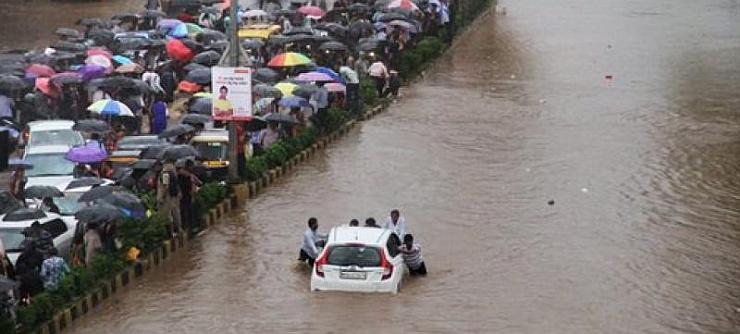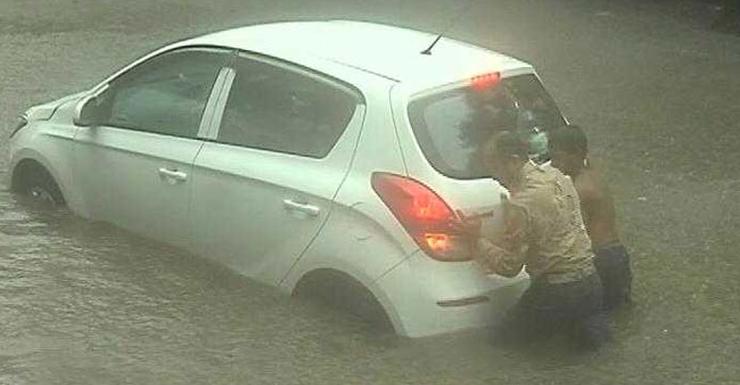With the onset of monsoons in the Indian mainland, many roads across the major cities and towns of the country will vanish under the water. In the past, there have been many instances when the cars enter the flooded roads and go kaput. But this year, before the rain starts and you have to go through the flooded roads again, we bring you top tips on how you should handle such roads. Be a pro this monsoon season and follow these tips.
Don’t try to judge the depth of the water level

If you’re well aware of the submerged road and know about every pothole and dip on it, you will probably know the best about the water level also and can decide if you want to take your vehicle through it. However, on unknown roads, getting out of the vehicle and walking through the submerged road is not a good idea. Why? Well, on flooded roads, the contaminated sewage water from underground sewages spillover. Also, the manhole covers can get displaced, which can be extremely dangerous. Sewage mixed with the rainwater can cause a lot of skin diseases so it is best to avoid.
Splashing through!

Stagnant water, the car at a good speed are a good fun way to enjoy the monsoons but it can damage your vehicle! Stagnant water can hit the vehicle with a lot of force and can dislodge the bumper of the vehicle. That’s only half of the problem, taking the vehicle through the water at high engine RPM can also hydro lock the vehicle. At high RPM, the car’s intake takes a high volume of air to burn the fuel and if by any chance, droplets of water enter the intake, the engine can get seized. One should also take care that if the water level is high, one should not drive at lower RPM to ensure that the water does not enter the exhaust. The best way is to drive smoothly at low gear and high rpm in such situations.
Don’t tailgate

Many people try to follow other cars through waterlogged roads. It may look like a safe option but it is not. When a vehicle moves through the water, it displaces a lot of water that creates ripples. These ripples make the water level higher by a few inches, which can make way to the air intake.
Following without knowing
If you’re not well aware of the road’s condition which is under the water, getting into it just because the other vehicle is doing so is not a good idea. It is possible that the other driver knows the area well or is just trying out his luck. It is always a good idea to wait and see. Also, one has to know their own vehicle and know how much water it can wade through. Owners should take care of turbocharged engines more as they suck in more air than the naturally aspirated engines.
Follow the safest line

Most modern-day roads are designed to displace the water quickly and they are higher in the middle to keep the water out of the roads. If you have no other option than to cross the road, taking the central line is the best as the water level is likely to be the lowest in the middle of the road.
Don’t crank if it stalls

If the engine shuts off in the middle of the road due to water entering the air intake, do not try to start the vehicle. The combustion stops whenever water is detected in the engine and if this is the case, cranking the engine further damages the vehicle. Hydrolocking of the engine should be handled only by professionals and the vehicle should only be moved with the help of a crane or tow truck.
Look for alternate routes
It is quite possible that there are multiple roads leading to the same destination. A few roads can be completely submerged underwater while the other can go through high areas and do not get submerged. Even if it is a longer journey compared to the regular route, always take the high roads. It is always better than getting stuck midway in a flooded road.
Don’t panic brake

Using the brakes in panic when on the flooded roads can cause the vehicle to stop. The road surface under the water is not visible clearly and it is quite usual to hit a pothole or a speed breaker. One should always ensure a constant input of the accelerator when on submerged roads else, the water can overpower the pressure of the exhaust gases and gush in rapidly.
Check your brakes
After crossing a waterlogged street, it is important to inspect the vehicle’s brakes. Flooded roads have a lot of garbage that can get stuck to the brake and hang from the underbody of the vehicle. Always stop after coming out of the flooded roads and apply the brakes for a few times. Applying the brakes ensure that they become dry rapidly and keeps them effective.
Wait

Probably, this is the best thing to do! Waiting for the water to subside after the rain is the best you can do to your car during the monsoons. If you’re already on the road, find a secure spot and park the vehicle with hazard lights on. Waiting for a couple of hours can keep you out of a lot of trouble.
Also Read: Kia Seltos compact SUV's front end revealed through new teaser ahead of official unveil